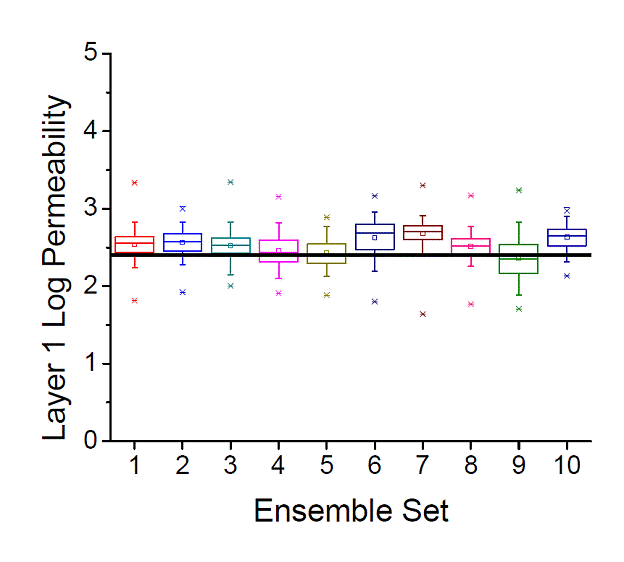57th Annual Report on Research 2012 Under Sponsorship of the ACS Petroleum Research Fund
Reports: ND951041-ND9: Accurate Hydraulic Fracture Characterization Using Microseismic and Production/Welltest Data
Jingyi Chen, University of Tulsa
The objective of this project is to pair the perforation timing measurement together with the production/welltest data to yield a better velocity structure which provide more accurate characterization of the fracture development from microseismic inversion and also help resolve or quantify the rock property fields far from wells. The more accurate fracture and reservoir description obtained from the inversion of microseismic data provides us the opportunity to maximize the hydrocarbon recovery with better reservoir management strategies.
We first developed a forward model for traveltime computation of seismic waves penetrating the media of complex velocity structure. The forward model is based on the Eikonal equation with the finite-difference method for the heterogeneous media. From sensitivity analysis of the microseismic first arrival times to the velocity structure, it is found that in a horizontal multi-layered velocity structure, the first arrival time is most sensitive to the high velocity/lower porosity layers. From sensitivity analysis of the dynamic production/welltest data to the multi-layer rock properties fields and the velocity structure, it is shown that the dynamic production/welltest data are sensitive to thickness-weighted averaged permeability, but typically resolve only high permeability and porosity layers. Thus, Microseismic data and welltest data are complementary and integration of both data improves reservoir characterization.
We started with a two-layer homogenous case with a producer in the middle of reservoir and monitor well 3000ft away. There are perforations in the middle of each layer and receivers which can record P- and S- wave signals during perforation at the monitor well on the top of reservoir layers. The producer is then put on production with a constant rate for 2 days and shut down in for another 2 day. The P- and S-wave first arrival times during perforation and pressure data during drawdown and buildup are assimilated to update porosity and log-permeability of both layers by Ensemble Kalman Filter (EnKF). Since EnKF is a stochastic process, this case was run 10 times with different priors. As shown in Fig 1, by assimilating only pressure data, the estimation of log permeability in lower permeability layer are quite different from different prior ensemble sets. By assimilating both microseismic and pressure data as shown in Fig 2, the results of each ensemble set are relatively close. The majority of the posterior mean are close to the true and the uncertainty is lower than assimilating only pressure data in most of the cases. Similar improvements are observed in other estimation such as porosity, permeability and layer rate in all layers.
The problem of determining the event location is treated as inversion, where we minimize the misfit between the predicted and observed first-arrival times under the assumption that velocity structure is known. Singular Value Decomposition (SVD) method is used for minimization. In first case, we estimated microseismic event locations when 12 geophones are placed at the surface. By visual inspection in 3D plot, the estimated event locations match the true fracture location even though there is some noise in the signal. The crossplots of the event location coordinates between the true and estimated show the quantitative comparison between the true and estimated event locations. All the estimated coordinates have very good correlations with the true coordinates and the estimated initiation times match the true initiation times very well.
By matching the first arrival times on surface geophones, we obtained good estimate on the microseismic event locations. However, the microseismic signal strength may not be good enough when the geophones are placed at the surface. In the second case, we place the geophones in nearby monitoring wells. From visual inspection in 3D plot, we are able to obtain good estimate on the event locations, although the estimated event depth is less accurate compared to the case in which the geophones are placed at the surface. The sensitivity study shows that the gradient of the objective function with respect to depth is much smaller in this case than the case that has the geophones at the surface.
In summary, as shown in sensitivity analysis and a two-layer homogenous case, microseismic data and welltest data are complementary and integration of both data improves reservoir characterization. In the problem of determining event location assuming velocity structure is known, very accurate microseismic event locations are obtained with geophones placed at the surface. When geophones are placed in the downhole of nearby wells, less accurate event locations are obtained. However, in both cases, we are able to use the inverted event locations characterize the fracture propagation. The inversion of event location and velocity and the integration of microseismic and welltest data in heterogeneous case will be tested in the next year of this project.
Fig 1
Estimations of log permeability in layer 1 of all ensemble sets by assimilating
pressure data only.
Fig
2 Estimations of log permeability in layer 1 of all ensemble sets by
assimilating microseismic and pressure data.










